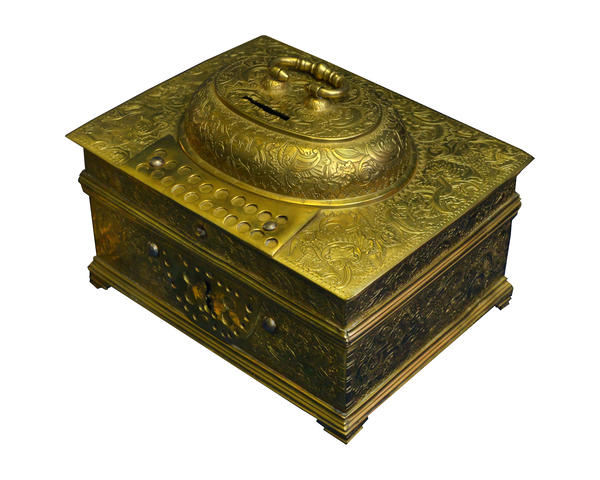People kept jewelry and other valuables in brass and copper caskets in the olden days. But the chests themselves were often valuable items - mainly due to their exquisite decoration. Researchers note the influence of the Baroque and the Rococo styles in the design of the jewelry boxes of the XVIII century, manifested in the intricate plant patterns, depicting animals and genre scenes. Such ornaments were engraved on the jewelry boxes.
A jewelry box
Время создания
Mid-18th century
Размер
22x28,5x22 cm
22x28.5x22 cm
22x28.5x22 cm
Техника
Embossment, forging
Выставка
0
Открыть в приложении#1
A jewelry box
#2
#7
The surface of the jewelry box presented in the exhibition is decorated with embossed ornaments of shells, whorls and birds. The pattern also features images of animals, a couple in love and hunting people. The front part of the cover and the space around the keyhole are decorated with overlaid plates with numerous through-holes. The jewelry box stands on four three-tiered legs, and there is an oval elevation with a half-ring-shaped handle in the center of its lift-up lid.
#8
This jewelry box was made at the Irginsky plant [zavod] that belonged to the Osokin family. It got its name from the Irgina River, near which the production complex construction began in 1728. Two years later, the blast furnace of the iron and copper smelting plant, owned by cousins Peter and Gavrila Osokin, was put into operation. They were craftsmen from the Balakhnin uyezd, Nizhny Novgorod Gubernia [Governorate]. They did not get the right to build near the Irgina River immediately as they had to compete for the land with Moscow merchants for nearly a year with the clerk Rodion Nabatov facilitating their efforts. The dowser and Old Believer [schismatic] gained for his superiors the right to hire strangers and buy landless peasants. Thanks to this, many runaway peasants were employed at the Irginsky plant, most of whom were Old Believers from Nizhny Novgorod.
#9
The products of the Irginsky plant were widely known in Russia. For example, it was there that the Court Office of Empress Anna Ioannovna ordered cauldrons and pans in the first half of the XVIII century.
#10
The Irginsky plant was the first enterprise owned by the Osokin family, which soon became successful and respected industrialists who managed about ten profitable factories by the middle of the XVIII century. However the Osokins’ enterprises began to change hands by the end of the century, going from one wealthy buyer to another, with the Osokins gradually losing their influence.
#11
National Museum of the Republic of Tatarstan
читать дальшескрыть
00:00
00:00
1x
A jewelry box
Время создания
Mid-18th century
Размер
22x28,5x22 cm
22x28.5x22 cm
22x28.5x22 cm
Техника
Embossment, forging
Выставка
0
Открыть в приложении
Поделиться



